Luciano Lavagno
eIQ Neutron: Redefining Edge-AI Inference with Integrated NPU and Compiler Innovations
Sep 17, 2025Abstract:Neural Processing Units (NPUs) are key to enabling efficient AI inference in resource-constrained edge environments. While peak tera operations per second (TOPS) is often used to gauge performance, it poorly reflects real-world performance and typically rather correlates with higher silicon cost. To address this, architects must focus on maximizing compute utilization, without sacrificing flexibility. This paper presents the eIQ Neutron efficient-NPU, integrated into a commercial flagship MPU, alongside co-designed compiler algorithms. The architecture employs a flexible, data-driven design, while the compiler uses a constrained programming approach to optimize compute and data movement based on workload characteristics. Compared to the leading embedded NPU and compiler stack, our solution achieves an average speedup of 1.8x (4x peak) at equal TOPS and memory resources across standard AI-benchmarks. Even against NPUs with double the compute and memory resources, Neutron delivers up to 3.3x higher performance.
A Survey on Design Methodologies for Accelerating Deep Learning on Heterogeneous Architectures
Nov 29, 2023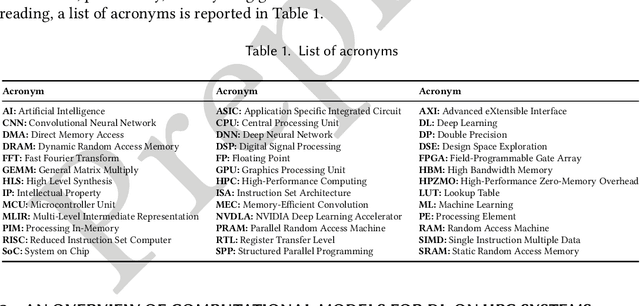
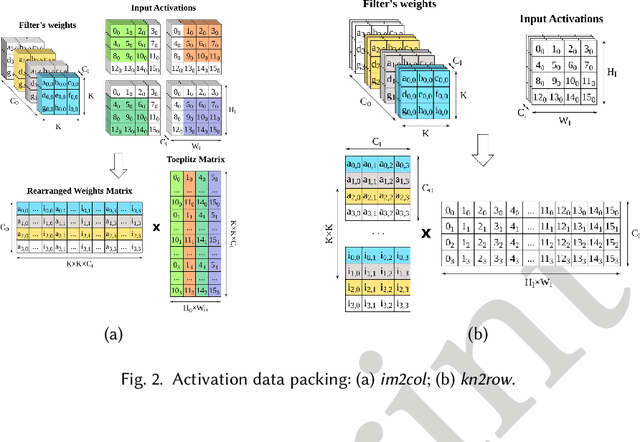
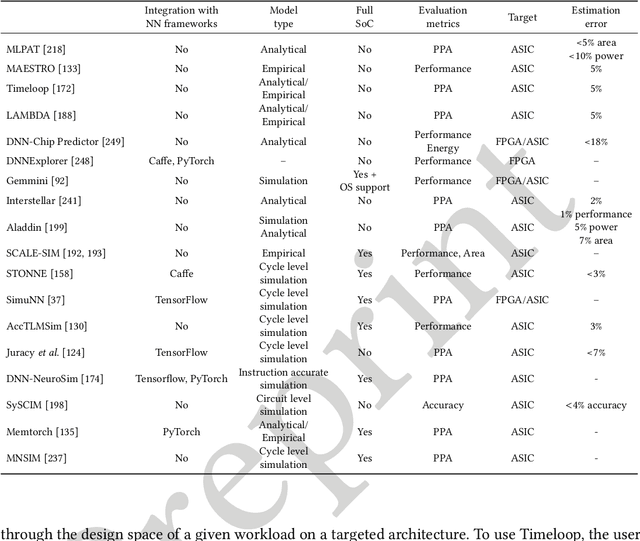
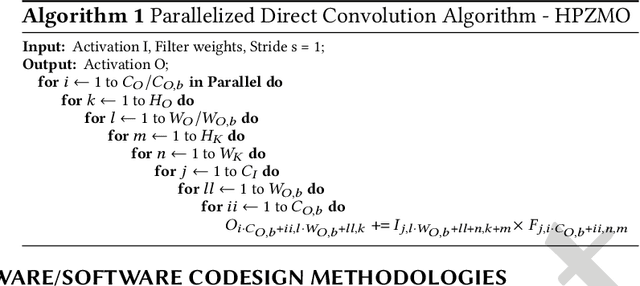
Abstract:In recent years, the field of Deep Learning has seen many disruptive and impactful advancements. Given the increasing complexity of deep neural networks, the need for efficient hardware accelerators has become more and more pressing to design heterogeneous HPC platforms. The design of Deep Learning accelerators requires a multidisciplinary approach, combining expertise from several areas, spanning from computer architecture to approximate computing, computational models, and machine learning algorithms. Several methodologies and tools have been proposed to design accelerators for Deep Learning, including hardware-software co-design approaches, high-level synthesis methods, specific customized compilers, and methodologies for design space exploration, modeling, and simulation. These methodologies aim to maximize the exploitable parallelism and minimize data movement to achieve high performance and energy efficiency. This survey provides a holistic review of the most influential design methodologies and EDA tools proposed in recent years to implement Deep Learning accelerators, offering the reader a wide perspective in this rapidly evolving field. In particular, this work complements the previous survey proposed by the same authors in [203], which focuses on Deep Learning hardware accelerators for heterogeneous HPC platforms.
Design and Optimization of Residual Neural Network Accelerators for Low-Power FPGAs Using High-Level Synthesis
Sep 27, 2023Abstract:Residual neural networks are widely used in computer vision tasks. They enable the construction of deeper and more accurate models by mitigating the vanishing gradient problem. Their main innovation is the residual block which allows the output of one layer to bypass one or more intermediate layers and be added to the output of a later layer. Their complex structure and the buffering required by the residual block make them difficult to implement on resource-constrained platforms. We present a novel design flow for implementing deep learning models for field programmable gate arrays optimized for ResNets, using a strategy to reduce their buffering overhead to obtain a resource-efficient implementation of the residual layer. Our high-level synthesis (HLS)-based flow encompasses a thorough set of design principles and optimization strategies, exploiting in novel ways standard techniques such as temporal reuse and loop merging to efficiently map ResNet models, and potentially other skip connection-based NN architectures, into FPGA. The models are quantized to 8-bit integers for both weights and activations, 16-bit for biases, and 32-bit for accumulations. The experimental results are obtained on the CIFAR-10 dataset using ResNet8 and ResNet20 implemented with Xilinx FPGAs using HLS on the Ultra96-V2 and Kria KV260 boards. Compared to the state-of-the-art on the Kria KV260 board, our ResNet20 implementation achieves 2.88X speedup with 0.5% higher accuracy of 91.3%, while ResNet8 accuracy improves by 2.8% to 88.7%. The throughputs of ResNet8 and ResNet20 are 12971 FPS and 3254 FPS on the Ultra96 board, and 30153 FPS and 7601 FPS on the Kria KV26, respectively. They Pareto-dominate state-of-the-art solutions concerning accuracy, throughput, and energy.
To Spike or Not To Spike: A Digital Hardware Perspective on Deep Learning Acceleration
Jun 27, 2023



Abstract:As deep learning models scale, they become increasingly competitive from domains spanning computer vision to natural language processing; however, this happens at the expense of efficiency since they require increasingly more memory and computing power. The power efficiency of the biological brain outperforms the one of any large-scale deep learning (DL) model; thus, neuromorphic computing tries to mimic the brain operations, such as spike-based information processing, to improve the efficiency of DL models. Despite the benefits of the brain, such as efficient information transmission, dense neuronal interconnects, and the co-location of computation and memory, the available biological substrate has severely constrained the evolution of biological brains. Electronic hardware does not have the same constraints; therefore, while modeling spiking neural networks (SNNs) might uncover one piece of the puzzle, the design of efficient hardware backends for SNNs needs further investigation, potentially taking inspiration from the available work done on the artificial neural networks (ANN s) side. As such, when is it wise to look at the brain while designing new hardware, and when should it be ignored? To answer this question, we quantitatively compare the digital hardware acceleration techniques and platforms of ANN s and SNNs.
A Survey on Deep Learning Hardware Accelerators for Heterogeneous HPC Platforms
Jun 27, 2023



Abstract:Recent trends in deep learning (DL) imposed hardware accelerators as the most viable solution for several classes of high-performance computing (HPC) applications such as image classification, computer vision, and speech recognition. This survey summarizes and classifies the most recent advances in designing DL accelerators suitable to reach the performance requirements of HPC applications. In particular, it highlights the most advanced approaches to support deep learning accelerations including not only GPU and TPU-based accelerators but also design-specific hardware accelerators such as FPGA-based and ASIC-based accelerators, Neural Processing Units, open hardware RISC-V-based accelerators and co-processors. The survey also describes accelerators based on emerging memory technologies and computing paradigms, such as 3D-stacked Processor-In-Memory, non-volatile memories (mainly, Resistive RAM and Phase Change Memories) to implement in-memory computing, Neuromorphic Processing Units, and accelerators based on Multi-Chip Modules. The survey classifies the most influential architectures and technologies proposed in the last years, with the purpose of offering the reader a comprehensive perspective in the rapidly evolving field of deep learning. Finally, it provides some insights into future challenges in DL accelerators such as quantum accelerators and photonics.
Synetgy: Algorithm-hardware Co-design for ConvNet Accelerators on Embedded FPGAs
Nov 21, 2018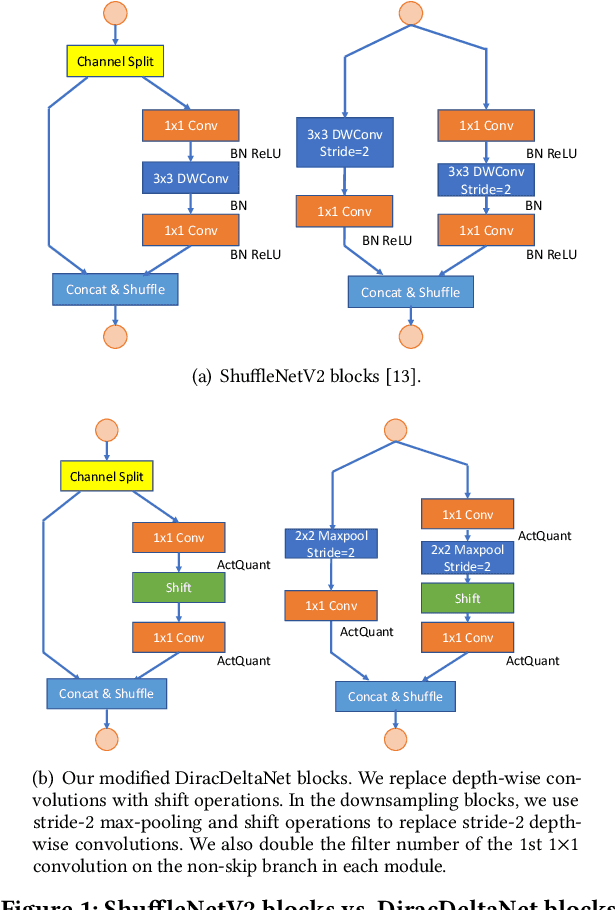
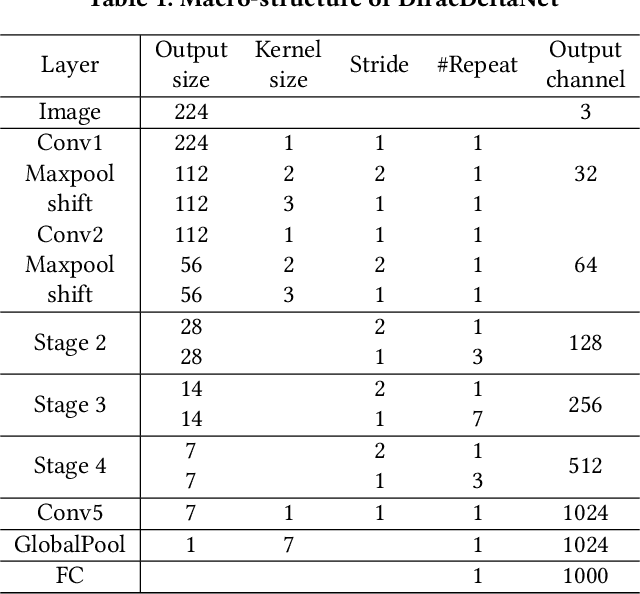
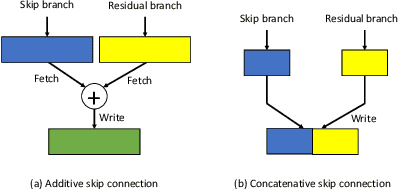
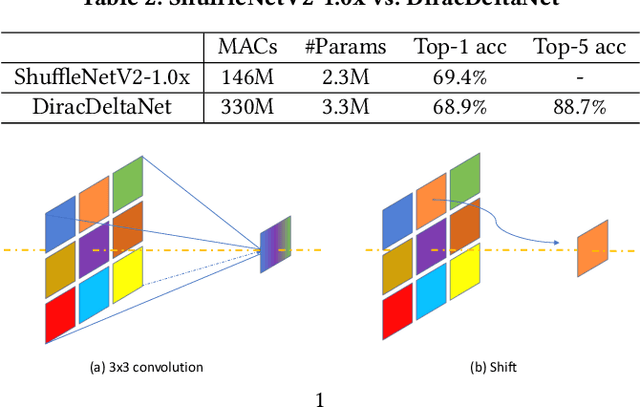
Abstract:Using FPGAs to accelerate ConvNets has attracted significant attention in recent years. However, FPGA accelerator design has not leveraged the latest progress of ConvNets. As a result, the key application characteristics such as frames-per-second (FPS) are ignored in favor of simply counting GOPs, and results on accuracy, which is critical to application success, are often not even reported. In this work, we adopt an algorithm-hardware co-design approach to develop a ConvNet accelerator called Synetgy and a novel ConvNet model called DiracNet. Both the accelerator and ConvNet are tailored to FPGA requirements. DiractNet, as the name suggests, is a ConvNet with only 1x1 convolutions while spatial convolutions are replaced by more efficient shift operations. DiracNet achieves competitive accuracy on ImageNet (89.0% top-5), but with 48x fewer parameters and 65x fewer OPs than VGG16. We further quantize DiracNet's weights to 1-bit and activations to 4-bits, with less than 1% accuracy loss. These quantizations exploit well the nature of FPGA hardware. In short, DiracNet's small model size, low computational OP count, ultra-low precision and simplified operators allow us to co-design a highly customized computing unit for an FPGA. We implement the computing units for DiracNet on an Ultra96 SoC system through high-level synthesis. The implementation only took 2 people 1 month to complete. Our accelerator's final top-5 accuracy of 88.3% on ImageNet, is higher than all the previously reported embedded FPGA accelerators. In addition, the accelerator reaches an inference speed of 72.8 FPS on the ImageNet classification task, surpassing prior works with similar accuracy by at least 12.8x.
 Add to Chrome
Add to Chrome Add to Firefox
Add to Firefox Add to Edge
Add to Edge